Soft marketing is a gentle, trust-based way to sell digital products, courses, coaching, and consulting. It focuses on authentic relationship-building and value, helping attract customers naturally – without pressure, hype, or pushy sales tactics.
–
For The GENTLE Method that builds trust and drive sales, go here.
What is Soft Marketing?
Soft marketing means selling by helping first. If you sell digital products, run courses, coach people, or consult, you focus on building trust.
- You teach
- You share stories
- You provide value before ever asking for the sale
Customers today ignore pushy ads. They want proof, answers, and respect. Hard selling uses urgency and manipulation. Soft marketing takes the opposite path: patient education and human connections.
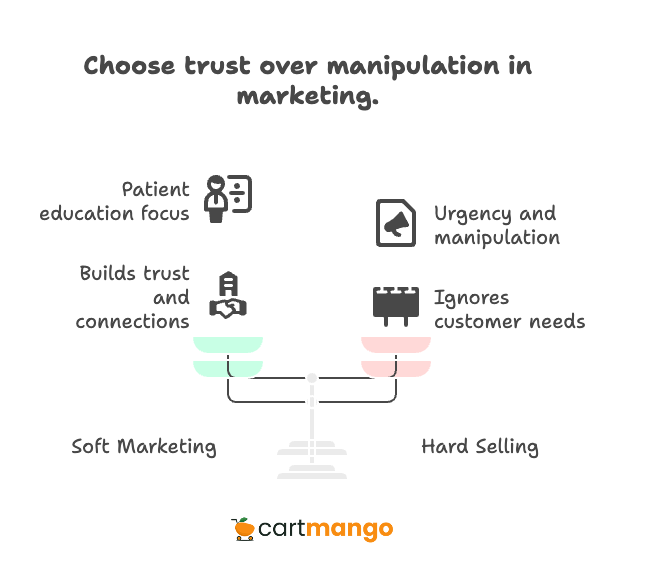
- A digital product seller shares a how-to guide or demo
- Course creators give lesson previews and answer questions
- Coaches and consultants show real client stories and case studies
Soft marketing works because it feels safer for buyers. When you sell gently, you build trust and reputation – the kind people talk about with friends. 81% of people won’t even think about buying from a business unless they trust it first (Source: Edelman).
Why Soft Marketing Works for Digital Creators
You want real customers who come back. That’s why trust matters more than anything.
- Course creators see better results when students refer friends.
- Digital product sellers need loyal fans and users, not just one-time buyers.
- Coaches rely on client testimonials and referrals.
- Consultants grow with repeat clients and positive word of mouth.
Real sales come from relationships built over time. You don’t need thousands of email subscribers. You need a handful of engaged buyers who trust you to solve their problems.
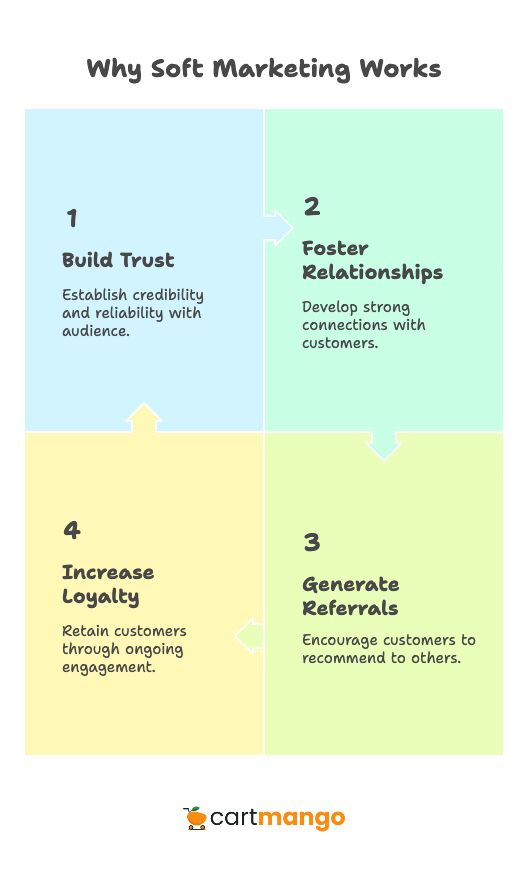
Authenticity is a real business advantage. 88% of consumers trust recommendations from people they know above all other forms of marketing messaging (Source: Nielsen).
Selling softly means your product stands out for its usefulness. Your course wins because you connect, not because you shout the loudest. Coaches and consultants build their reputation slowly, one satisfied client at a time.
If you’re independent, patience pays off. The Harvard Business Review found that increasing customer retention by as little as 5% can lift profits by 25% to 95% (Source: Harvard Business Review).
What does that mean?
Focusing on value and relationships (a.k.a. soft marketing) makes your income more steady and predictable.
The GENTLE Method That Builds Trust & Drive Sales (without pressure)
G = Groups
E = Email nurture sequences
N = Narratives
T = Tender CTAs (call to action)
L = Learning content
E = Engagement
| Tactic | Digital Product Sellers | Course Creators | Coaches & Consultants |
|---|---|---|---|
| Groups (Community Building) | Discord group, feedback thread | Facebook group, student forum | Mastermind, group calls, live chats, Slack/LinkedIn group |
| Email Nurture Sequences | Sample file or checklist, welcome series | Mini course, email resource series | Action plans, weekly advice, consulting starter guides |
| Narratives (Storytelling/Case Studies) | Buyer success stories, demo videos | Student testimonials, module previews | Client transformation stories, before/after case studies |
| Tender CTAs (Soft Call-to-Action) | Download free sample, see how product works | Preview the course, free lesson | Book an intro call, request a consult, get a tip |
| Learning Content (Value Blog/Video) | How-to guides, asset tips | Free lessons, FAQ content | Training snippets, mindset tips, explainers, industry tips |
| Engagement (Social Media) | Share user content, product tips | Live Q&As, group challenges | Daily insights, DMs/questions, LinkedIn advice, comments |
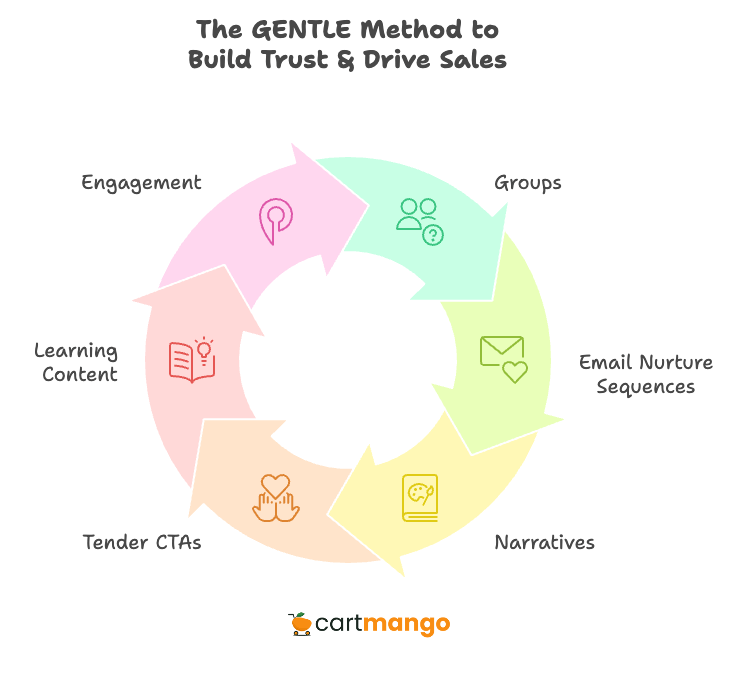
1/ Groups (Community Building)
Start a Facebook group or Discord for your buyers and fans. Provide a space for questions and feedback.
Course creators, invite students to group discussions.
Coaches and consultants, run mastermind calls or networking events in Slack. The goal is simple: keep the conversation going after the sale.
2/ Email Nurture Sequences
Start with a welcome email.
Offer a checklist, template, or mini-guide. Don’t pitch immediately.
Share a short series (3 to 5 emails) that provides real help, maybe a tip of the day or a “starter guide.”
For product sellers, this could be a free Notion template.
For consultants, an onboarding checklist. BirdSend and Mailchimp are two quick options for setting this up.
3/ Narratives (Storytelling/Case Studies)
Use stories buyers understand.
If you sell planning templates, share a real user’s experience with dates and results.
When a coach shows a client’s journey, cite the client and results.
Course creators, feature a student’s testimonial after they finish a module.
Consultants, share a before-and-after business turnaround and link to the client’s site if they allow.
4/ Tender CTAs
Let customers decide.
Say “Download a free sample,” instead of “Buy now.”
Invite exploration with “Preview this course” or “Book an intro call.”
Coaches and consultants, replace pressure with permission. Ask, “Want to see if we’re a fit? Book a short intro call.”
Digital sellers can offer “Get a free demo video” before showing their product.
Sales come because the customer feels respected, not rushed.
5/ Learning Content (Value)
Write guides that solve problems.
A digital seller might create a tutorial like “How to use my Notion template to save 1 hour each week.”
Course creators offer sample lessons, walking prospects through the material.
Coaches or consultants can share video snippets about a tip that worked for clients. Choose your format: video, podcast, or blog.
Provide answers for free. A podcast episode or short video can answer a common question and build goodwill. FAQ content clears confusion before it blocks the sale.
6/ Engagement (Social Media)
Focus on engagement, not reach.
Answer questions in Facebook groups or share tips on Instagram.
Course creators can host monthly live Q&A sessions, addressing real problems.
Coaches and consultants should answer DMs with a quick tip rather than a script.
Group challenges work. Invite your audience to use your product or follow a mini-course for a week, then share their experiences. Recognize the effort: repost their stories, mention them in your posts.
Getting Started with Soft Marketing
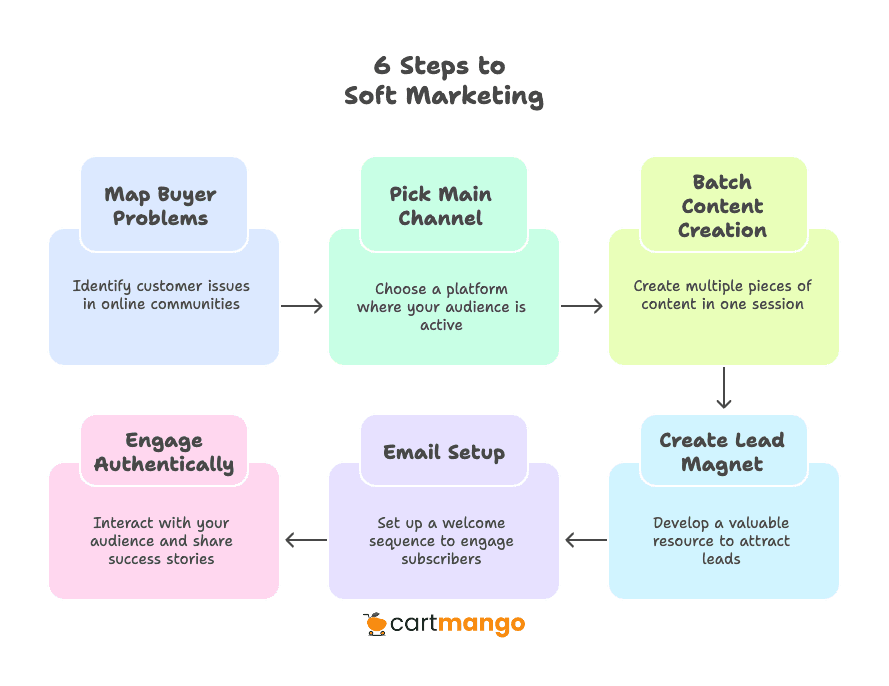
| Step | Task | Example Tool/Resource |
|---|---|---|
| 1. Map Buyer Problems | Research forums/reviews and collect phrases | Reddit, Quora, FB Groups |
| 2. Pick Main Channel | Select & set up profile / content plan | Instagram, LinkedIn, YouTube |
| 3. Batch Content Creation | Plan & produce 4–8 pieces / month | Google Docs, Canva, Loom |
| 4. Create Lead Magnet | Create a simple but useful free checklist / sample / guide | Canva, Notion, Google Docs |
| 5. Email Setup | Set up welcome series for new leads | BirdSend, Mailchimp |
| 6. Engage Authentically | Reply to DMs/comments, spotlight wins | Platform DMs, Community Forum |
1/ Map Buyer Problems
Join groups and marketplaces where your customers share issues.
As a seller, read marketplace reviews.
As a coach or consultant, look for open threads about challenges in Facebook groups or Reddit.
Write down their own words; this is the language you need in your content.
2/ Pick Main Channel
Pick just one place to start.
It could be Instagram for product sellers. LinkedIn for consultants. YouTube for course creators who want to teach with video.
The key? Pick the platform your best audience actually uses, not just the one you like.
Update your profile with “how I can help”.
Plan a month of value posts that answer specific questions.
3/ Batch Content Creation
Set aside time to create 4 to 8 pieces of content at once. Maybe it’s a weekly tip, a FAQ video, or a product walkthrough.
Store your drafts in Google Docs or Canva. This lets you spend less time thinking “what should I post today?”
4/ Create Lead Magnet
Think about one problem you can solve quickly.
Design a checklist, template, or how-to guide. Canva or Notion work fine for most digital creators.
For example, a Notion seller might give away a “5-Step Weekly Planner.” Consultants could offer a “Client Onboarding Cheat Sheet.”
5/ Email Setup
Create a welcome sequence with BirdSend. Start with a thank you message. Share your lead magnet inside. Plan 2-4 more emails, each one focused on solving a small challenge or giving a tip.
Don’t pitch right away.
Let readers warm up.
The goal is to show you can help before you ask for a sale.
6/ Engage Authentically
Reply to every DM and comment personally.
Share wins from clients and customers. Repost case studies when possible.
Spotlight real user stories. Ask your audience what they want, then deliver. Show up often enough that people recognize your name, but don’t overpromise.
Common Soft Marketing Mistakes to Avoid
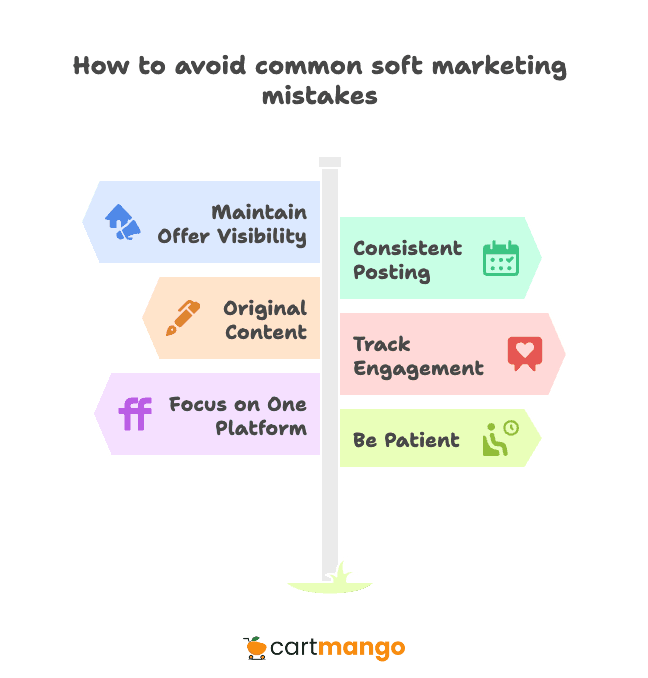
- If you never mention your offer, people forget you exist.
- If you stop posting after launch, buyers lose trust.
- Copying others rarely works. If you run a solo business, make your own voice heard.
Track engagement: who’s responding, who asks questions, who downloads. Pageviews mean less than real conversations.
Don’t try five platforms at once; one is enough. Adding more too early drives confusion.
Results often take months or even years. Successful creators built steady followings with a simple, regular posting schedule, not with flash sales or big launches.
Avoid getting impatient and switching back to quick promotions. If your advice helps, sales will follow later.
Sometimes you’ll doubt the method. I’ve seen creators go quiet and lose momentum fast. Don’t underestimate consistency.
Soft vs Hard Marketing
Understanding how soft marketing fits alongside other marketing strategies can give you clarity when planning your marketing campaigns.
In traditional marketing and digital marketing, the hard sell was often considered the primary sales strategy.
This hard marketing approach centers on direct, sometimes aggressive, marketing messages, social media ads, outbound marketing, and sales techniques focused on pushing potential customers to make a purchase immediately.
Soft marketing and hard marketing differ in important ways. While hard sell and soft sell can both be effective, the soft vs hard sell debate is about customer experience and long-term customer relationships.
Soft marketing strategies focus more on building a community, user-generated content, and engaging with your target audience. B2B and online marketing have seen a shift; many experts in their field now value customer engagement, feedback from customers, and content that resonates over classic negotiation strategy and direct asks.
There are real advantages and disadvantages to each approach.
Hard marketing and traditional marketing can generate quick conversion rates but may discourage loyal customers and brand loyalty.
Soft marketing aims to grow a loyal customer base and develop meaningful customer relationships through valuable insights, responsive social media marketing, and patient marketing efforts.
The Bigger Picture
If your goal is business growth and marketing success over time, soft marketing offers a reliable sales system.
Social media platforms enable you to build relationships, engage with customers, and encourage brand awareness. Tools such as SEO, influencer collaborations, and even classic user-generated content campaigns help expand your customer base and increase conversion, instead of only looking for those ready to buy.
Soft marketing doesn’t exclude metrics or conversion rates. In fact, tracking the right metric can help you spot which content marketing strategies lead to customer engagement and which online marketing tactics bring you closer to your goals.
The best marketing plan combines both approaches. Knowing when to go for a hard sell vs a soft approach, how to use marketing tools to engage with customers, and how to build a satisfied, likely to engage audience.
Sales and marketing teams that respond to comments, build a community, and focus their marketing efforts on valuable customer experience often create loyal customer relationships.
These are the foundations of a successful business. Your marketing messages, over time, should not just push for the next conversion but help create content, encourage feedback from customers, and strengthen your customer base.
Your Turn
Soft marketing leads to soft selling. Both fuel lasting growth.
Pick a soft strategy. Use it weekly.
Focus on solving problems, talking to your audience, and inviting feedback. That’s how you build a business people trust enough to buy from again and again.
Genuine value compounds. Sales follow.
Related Reading
- Sellfy vs Payhip: The Recurring Revenue Prison (2026)
- Podia vs Gumroad: The Recurring Revenue Handcuffs (2026)
- SendOwl vs Gumroad: The Recurring Revenue Black Hole (2026)
- Gumroad vs Sellfy: The Vendor Lock-in Cage (2025)
- Gumroad vs Payhip: The Hidden Trap for Creators (2025)
- ThriveCart vs SamCart – The Subscription Hostage Trap (2025)
- 8 ThriveCart Alternatives & The Lifetime Pricing Paradox (2025)
- 8 SamCart alternatives + Subscription hostage (2025)
- The GENTLE Method: Soft marketing for creators
- How Far in Advance Should You Promote a Webinar?
